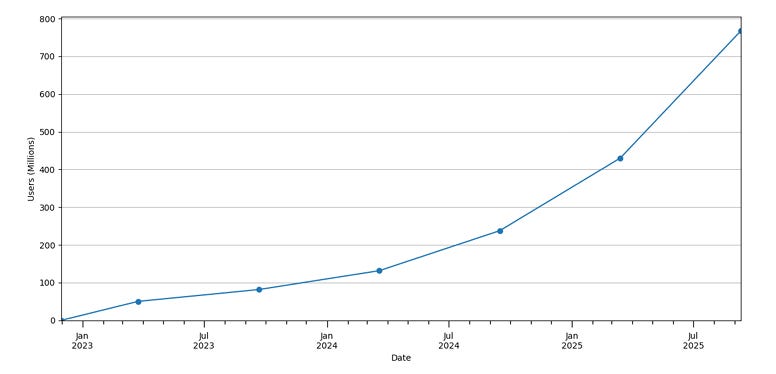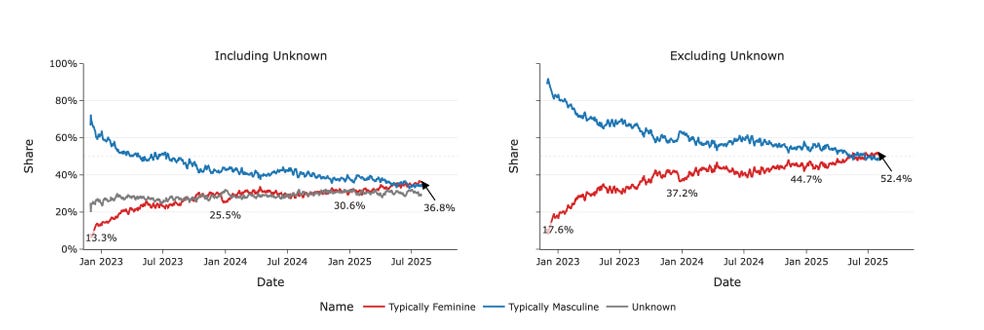70% of ChatGPT usage is not work-related: What are we really doing with AI?
A new study has revealed surprising data on how more than 700 million people worldwide are using ChatGPT, about 10% of the global adult population.
The research, conducted by scholars from Duke University, Harvard University, and OpenAI and published by the National Bureau of Economic Research (NBER), analyzed millions of conversations while preserving user privacy and brought important findings.
The results challenge many assumptions about AI and paint a picture that is much more diverse than we might have imagined.
Follow our page on LinkedIn for more content like this! 😉
The impressive scale of ChatGPT
Since its launch in November 2022, ChatGPT has reached impressive milestones: more than 700 million weekly active users, representing about 10% of the global adult population. Every day, over 2.5 billion messages are sent — the equivalent of 29,000 messages per second.
No technology in human history has ever achieved such rapid global adoption.
What the study revealed about real usage
1. Personal use outweighs professional use
One of the study’s most striking findings is that 70% of ChatGPT messages are for personal rather than professional use. This share has been consistently growing: in June 2024 it was 53%, rising to 73% a year later.
This suggests that the impact of generative AI on personal life may be as significant (or even greater) than in the workplace.
2. The three pillars of ChatGPT usage
Nearly 80% of all conversations fall into three main categories:
Practical Guidance: The most common category, including tutoring and teaching, advice across a wide range of topics, and creative idea generation. Education stands out as a core use case, accounting for 10% of all messages.
Information Seeking: Encompasses looking up information about people, current events, products, and recipes, serving as a close substitute for traditional search engines.
Writing: Covers creating emails, documents, and other forms of communication, as well as editing, critiquing, summarizing, and translating user-provided texts. Writing is the most common use case in professional settings, accounting for 40% of work-related messages in June 2025.
3. A revolution in writing
Another key insight: two-thirds of writing tasks involve modifying existing user-provided text rather than generating entirely new content. This highlights ChatGPT’s role more as a collaborative editor than a ghostwriter.
4. Education as a primary use case
Surprisingly, 10.2% of all messages are requests for tutoring or teaching. This makes education one of ChatGPT’s main use cases, underlining its transformative potential for learning.
Who uses ChatGPT?
The gender gap has disappeared: when ChatGPT was first launched, about 80% of users had typically male names. By June 2025, the balance had shifted, with users with female names representing a slight majority of active users.
Nearly half of all messages come from people under 26, confirming that younger generations are leading the adoption of this technology.
Growth is also faster in low- and middle-income countries, expanding access to cutting-edge AI worldwide.
Insights on usage behavior
Asking vs. Doing vs. Expressing
The study introduced a new taxonomy:
Asking (49%): Seeking information to make better decisions
Doing (40%): Requesting ChatGPT to perform specific tasks
Expressing (11%): Conversations without a clear informational goal
Interestingly, “Asking” messages have grown the fastest and receive the highest quality ratings from users.
Occupational differences
Professionals in technical and higher-paying fields are more likely to use ChatGPT for work, especially for:
Documenting and interpreting information
Making decisions and solving problems
Thinking creatively
Myths debunked
The study challenges two common perceptions:
Programming does not dominate usage: Only 4.2% of messages are about coding, far less than with other specialized chatbots.
Therapeutic use / companionship / socio-emotional support is limited: Just 1.9% of messages deal with relationships and personal reflection, contradicting earlier studies suggesting this was the most prevalent use.
Implications for the Future
Economic value beyond work
The data suggest that ChatGPT generates significant economic value by supporting decision-making, especially in knowledge-intensive work. This goes beyond task automation, positioning AI as a digital advisor.
Democratization of expertise
Growth in lower-income countries and the predominant use for practical guidance indicate that ChatGPT is democratizing access to specialized knowledge globally.
Conclusion
This study reveals that we are experiencing a silent revolution. ChatGPT is not just a productivity tool, but a multifunctional instrument blending work, learning, and personal life.
Generative AI is proving to be a truly transformative technology, with impacts far beyond what we initially imagined. As this technology continues to evolve, we can expect even deeper changes in how we interact with information and knowledge.
For professionals and organizations, the message is clear: AI is not just about automation, it is about amplifying human capacity to think, create, and make better decisions.
This article is based on the study “How People Use ChatGPT” by researchers from Harvard University, Duke University, and OpenAI, published in September 2025.




